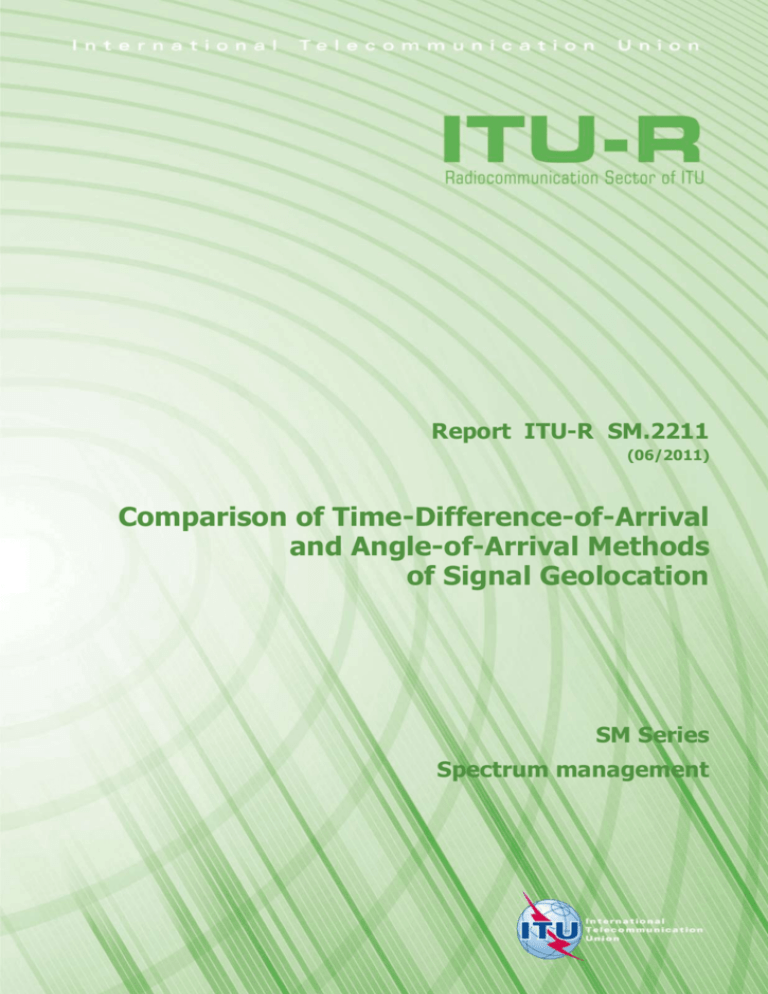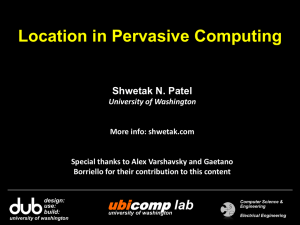
Report ITU-R SM.2211
(06/2011)
Comparison of Time-Difference-of-Arrival
and Angle-of-Arrival Methods
of Signal Geolocation
SM Series
Spectrum management
ii
Rep. ITU-R SM.2211
Foreword
The role of the Radiocommunication Sector is to ensure the rational, equitable, efficient and economical use of the
radio-frequency spectrum by all radiocommunication services, including satellite services, and carry out studies without
limit of frequency range on the basis of which Recommendations are adopted.
The regulatory and policy functions of the Radiocommunication Sector are performed by World and Regional
Radiocommunication Conferences and Radiocommunication Assemblies supported by Study Groups.
Policy on Intellectual Property Right (IPR)
ITU-R policy on IPR is described in the Common Patent Policy for ITU-T/ITU-R/ISO/IEC referenced in Annex 1 of
Resolution ITU-R 1. Forms to be used for the submission of patent statements and licensing declarations by patent
holders are available from http://www.itu.int/ITU-R/go/patents/en where the Guidelines for Implementation of the
Common Patent Policy for ITU-T/ITU-R/ISO/IEC and the ITU-R patent information database can also be found.
Series of ITU-R Reports
(Also available online at http://www.itu.int/publ/R-REP/en)
Series
BO
BR
BS
BT
F
M
P
RA
RS
S
SA
SF
SM
Title
Satellite delivery
Recording for production, archival and play-out; film for television
Broadcasting service (sound)
Broadcasting service (television)
Fixed service
Mobile, radiodetermination, amateur and related satellite services
Radiowave propagation
Radio astronomy
Remote sensing systems
Fixed-satellite service
Space applications and meteorology
Frequency sharing and coordination between fixed-satellite and fixed service systems
Spectrum management
Note: This ITU-R Report was approved in English by the Study Group under the procedure detailed
in Resolution ITU-R 1.
Electronic Publication
Geneva, 2011
ITU 2011
All rights reserved. No part of this publication may be reproduced, by any means whatsoever, without written permission of ITU.
Rep. ITU-R SM.2211
1
REPORT ITU-R SM.2211
Comparison of Time-Difference-of-Arrival and Angle-of-Arrival
Methods of Signal Geolocation
(2011)
Table of Contents
Page
1
Introduction ....................................................................................................................
1
2
Overview of TDOA Technology ....................................................................................
1
3
Strengths and weaknesses of TDOA compared with traditional AOA ..........................
2
4
Summary.........................................................................................................................
6
5
References ......................................................................................................................
7
1
Introduction
This Report compares the strengths and weaknesses of time-difference-of-arrival (TDOA) versus
angle-of-arrival (AOA) methods of signal geolocation. While this Report focuses on TDOA, it
should be noted that other geolocation techniques exist1. The AOA method determines the angle of
arrival of a wave at a measurement point. AOA methods have been commonly used in many
direction-finding applications, and have some advantages but also some disadvantages related to
antenna requirements, for example. TDOA methods, on the other hand, compute the time difference
of arrival of a wave at multiple measurement points, and calculate the source point based on timing
and wave comparisons. TDOA methods have not been widely used in spectrum monitoring, but
have become increasingly useful due to the availability of inexpensive and compact computing
power, more advanced radio receiver technology, ready availability of data links, and accurate
distributed timing signal availability. The paper will provide a short overview of TDOA technology
and some comparison of the strengths and weaknesses of the TDOA method compared to more
traditional AOA methods.
2
Overview of TDOA Technology
The TDOA technique measures the time of arrival of an RF signal at several points in space and
compares the time difference between each receiver. The traditional approach to estimating TDOA
is to compute the cross-correlation of a signal arriving at two receivers. The TDOA estimate is the
delay which maximizes the cross-correlation function. By knowing the location of each receiver, an
estimate of the location of the source of the emissions can then be deduced provided all receivers
1
Received signal strength (RSS) uses the measured power ratio of a signal at multiple measurement points
to compute the source point. RSS is often used for indoor geolocation. Frequency-difference-of-arrival
(FDOA) uses the frequency Doppler shift of a moving source (and/or multiple receivers) to calculate the
source point. FDOA is often used in conjunction with TDOA for airborne applications.
2
Rep. ITU-R SM.2211
are time synchronized. The complement to an AOA system’s line-of-bearing (LoB) is a hyperbolic
line of constant time difference of arrival referred to as an isochron or line-of-position (LoP). A
more complete discussion of TDOA methods is contained in the ITU Handbook on Spectrum
Monitoring, Edition 2011, Chapter 4.7.3.2.
TDOA methods have been used in radiolocation tasks in some defence applications, and more
recently in some specific applications such as location of mobile cellular telephones for emergency
responses (fire, ambulance, etc.) The main obstacle in the past to more pervasive civil deployment
has been the required nanosecond-level time synchronization. As electromagnetic radiation travels
at approximately 30 cm/ns, any significant timing jitter between receivers will translate directly into
the dilution of location accuracy. Today, the advent of satellite navigation systems (GPS, Galileo
and GLONASS) provides one such accessible and inexpensive means of maintaining time
synchronization. As a result, TDOA-based systems are now available today from several vendors in
different countries around the world.
3
Strengths and weaknesses of TDOA compared with traditional AOA
To better understand TDOA we present a short comparative survey of its strengths and weaknesses
with regard to AOA. It should be noted that TDOA and AOA are complementary techniques for
geolocation. A geolocation system that combines both may outperform either alone [1]. Also,
having an alternate and confirming method of geolocation can be crucial for spectrum enforcement
actions.
To simplify the discussion, we assume that the TDOA system uses cross-correlation based
detection, and that measurement receivers relay sampled signals to a central server for TDOA
processing. For most spectrum monitoring applications, this method will be preferred for both its
location performance and flexibility. To further simplify the discussion, we compare TDOA against
a correlative interferometer (CI) AOA system. Correlative interferometry is a widely implemented
AOA technique in modern radio monitoring. The correlative interferometer is introduced and
discussed in Chapter 4.7.2.2.5 of the ITU Handbook on Spectrum Monitoring, Edition 2011.
(NOTE 1 – “Chapter” references in Tables 3-1 and 3-2 refer to the ITU Handbook on Spectrum
Monitoring, Edition 2011. Numbers in parentheses in Tables refer to References listed in § 5.)
TABLE 3-1
TDOA strengths
Simpler antenna
requirements
The antenna is low cost, low complexity, and may be small in size.
TDOA receivers may employ a single simple antenna (such as a monopole or dipole).
Unlike AOA systems, the antenna does not require high mechanical tolerances and
electrical precision, and does not require operational test and measurement for
calibration. An added benefit is that the antenna may be made small in size and made
inconspicuous. This is important when deploying monitoring systems in historical or
architecturally restricted sites or when negotiating siting agreements with 3 rd parties.
Simpler siting and
calibration
requirements
Siting requirements are less restrictive than AOA and require little to no calibration.
This allows more flexibility in choosing TDOA sites. As a result, TDOA installations are
faster to deploy. In urban installations, additional TDOA receivers may be placed to
overcome the shadowing effects of tall structures.
In contrast, AOA sites must be chosen to minimize wave front distortion due to reemanation from local obstacles, ground reflections, and ground conductivity changes.
Some AOA antenna arrays must be calibrated after site installation to minimize the
resulting frequency and direction dependent errors. Antenna array calibration is one of
the most important performance limiting issues in AOA [2]. AOA siting issues are
discussed in further detail in Chapters 4.7.2.3.1.2 and 2.6.1.3.
Rep. ITU-R SM.2211
TABLE 3-1 (continued)
Wideband, low SNR
signals, and short
duration signals
TDOA performs well for new and emerging signals with complex modulations, wide
bandwidths, and short durations.
AOA typically performs well on narrow-band signals, but advanced AOA methods can
be applied for locating any signals including wideband, complex, and short duration.
TDOA performance is a strong function of signal bandwidth. AOA performance is
roughly independent of signal bandwidth provided that the FFT channel spacing is
similar to the signal bandwidth. TDOA performance generally improves as signal
bandwidth increases.
Both TDOA and AOA perform better on higher SNR signals and with longer integration
times. The processing gain from correlation allows TDOA techniques to detect and
locate low (and even negative) SNR signals. In addition, the correlation processing gain
enables additional TDOA receivers to participate in a geolocation although they may
have very low or negative SNR. Basic AOA techniques cannot detect and locate
negative SNR signals, and may have issues locating low SNR signals. Advanced AOA
techniques such as advanced resolution or data aided correlative AOA techniques
(reference DF) can process these signals.
Although basic AOA does not benefit from processing gain by signal correlation, it
benefits to some degree from the system gain which comes from the use of multiple
antenna elements and receiver channels.
Geolocation of short duration signals requires coordinated receivers, time synchronized
to a fraction of the inverse signal bandwidth. This capability is fundamental to TDOA
systems. In addition, TDOA can geolocate using very short duration measurements on
longer duration signals. If AOA antenna elements are commutated, then the required
integration duration will be decreased.
System complexity
The TDOA receiver and antenna are less complex than the typical AOA antenna array
and dual or multi-channel receiver.
A TDOA receiver requires at least one real time RF channel for gap free processing and
highest probability of signal interception(1). This may result in a less complex receiver in
simple radio environments. Advanced TDOA processing techniques are necessary when
using a simple receiver in complex radio environments. Efficient methods for time
synchronization (GPS) and data link interfaces are readily available.
Rejection of
uncorrelated noise and
interference
The correlation processing used in TDOA can suppress co-channel, time coincident
noise and interfering signals that are uncorrelated between sites. This property enables
the system to geolocate signals with low signal to interference + noise ratios (low SINR).
Time coordinated measurements are made at all receivers. Signals that are not common
to two or more receivers are suppressed. With advanced processing, a TDOA system
may geolocate using only correlations with the best observation of the emitted signal. A
related application of cross correlation techniques for interference analysis is given in
Chapter 4.8.5.5.
Advanced AOA systems may mitigate the effects of uncorrelated time coincident cochannel interference through the use of correlation with reference signals. Other
advanced processing techniques such as MUSIC can be robust to uncorrelated noise and
interference. However, such techniques are computationally expensive and not widely
used for spectrum monitoring.
Indoor, stadium, and
campus geolocation
With advanced processing techniques, TDOA may be used to geolocate high bandwidth
signals indoors and outdoors at short range (< 100 m on a side) and in high multipath
environments [4].
AOA systems typically do not perform well under these conditions. The challenge of
accurate indoor timing synchronization may be overcome with IEEE-1588 compatible
Ethernet switches and TDOA receivers. It should be noted that an alternate geolocation
technique using received signal strength (RSS), generally outperforms TDOA in high
multipath, short range environments, especially for narrowband signals.
3
4
Rep. ITU-R SM.2211
TABLE 3-1 (end)
Mitigates coherent
co-channel interference
(multipath) under
certain conditions
Both AOA and TDOA methods are compromised by multipath, also known as coherent
co-channel interference. Each method is impacted differently by the position of the
sensor in relation to the multipath reflections.
With sufficient signal bandwidth, TDOA is less sensitive to wave front distortion from
local obstacles (local multipath). TDOA may require advanced signal processing to
resolve location ambiguities caused by distant obstacles (distant multipath). Advanced
processing can further filter the correlation pairs used in the TDOA geolocation to
improve results under high multipath conditions. With advanced TDOA processing, time
resolved multipath between sites can be suppressed [5], resulting in good performance in
dense urban environments(2).
Geometry
considerations
Both TDOA and AOA are most precise when the signal source is centred within a
perimeter of measurement sites.
Geolocation precision in TDOA is determined by geometric dilution of precision
(GDOP), time synchronization quality, and TDOA estimation quality. The location
uncertainty is not directly related to the baseline distance between TDOA receivers [6].
This can be advantageous under certain conditions.
In contrast, the precision of AOA methods is directly related to the distance between the
source and each AOA receiver. AOA position uncertainty is a function of bearing angle
uncertainty and distance from the receiver to estimated position. When the source is far
outside the perimeter, TDOA approximates a line of position similar to AOA’s line of
bearing. In this situation, the uncertainty in location and bearing grows similarly with
distance for both methods.
Well suited to use in RF
sensor networks
For both TDOA and AOA, more receivers lead to better results through proximity gain
and improved statistics.
TDOA is well suited to multiple receiver deployments due to its lower complexity, size,
power, simpler antenna, and simplified siting requirements. A higher density of remote
monitoring stations, referred to as RF sensors above, brings the monitoring receiver
closer to the signal of interest. The resulting reduction in path loss, sometimes referred to
as ‘proximity gain’, improves detection and geolocation performance [7]. In addition,
the processing gain from correlation in TDOA techniques enables additional sensors to
participate in a geolocation although they may have very low or negative SNR.
Full offline analysis
possible at central
server
TDOA systems can store and catalogue time coordinated signal measurements from all
receivers, so full offline analysis is possible at a central server. This includes spectral
analysis of each receiver’s signal, cross correlation measurements, and geolocation.
AOA systems may also store and catalogue some signal measurements (such as bearing
results and bearing confidence) at a central server. These measurements are time
coordinated to the degree of time synchronization achievable in the AOA system.
Measurements such as spectral analysis and cross correlations are not typical as they
require similar backhaul data rate requirements as TDOA.
(1)
Typical correlative interferometry systems employ time-division multiplex (TDM) to reduce the number of
receivers required. These systems require two to three receivers switched among the 5, 7, or more antennas. These
systems are less complex than fully parallel DF systems but require a longer minimum signal duration for location.
(2)
TDOA has been reported to geolocate narrowband (30 kHz) AMPS cell phone signals in dense urban
environments to less than a few hundred feet r.m.s (5).
Rep. ITU-R SM.2211
TABLE 3-2
TDOA weaknesses
Narrowband signals
Slowly varying signals, which include unmodulated (CW) carriers and narrowband
signals, may be impossible or difficult to locate with TDOA techniques.
TDOA performance is a strong function of signal bandwidth and performance degrades
as signal bandwidth decreases. Also, multipath is potentially more of an issue for narrow
bandwidth signals when the signal’s temporal characteristics are wide relative to the
delay spread. Under these conditions the pulse-shape distortion caused by the multipath
is harder to discriminate, adding error to the time-difference estimation. The minimum
signal bandwidth for acceptable performance will vary by application. For example,
TDOA has been reported to geolocate narrowband (30 kHz) AMPS cell phone signals in
dense urban environments to less than a few hundred feet RMS [5]. Higher SNR
conditions and longer observation times can improve TDOA location for some
narrowband signals.
AOA systems perform well for narrowband and unmodulated signals as well as
wideband signals.
Single station homing
and standoff not
possible
A minimum of two TDOA stations, with at least one of those being mobile, and a data
link are required for the homing and standoff methods(1).
AOA homing and standoff geolocation methods are possible with just one portable
station. This allows for geolocation in environments where networked TDOA receivers
are impractical or not cost effective. These methods are described in Chapter 4.7.3.3.
Higher data rate
communication links
TDOA systems that transmit sampled waveforms from receivers to a central server
require high data rate communications links. The receiver’s networking needs are
asymmetric with upload bandwidth exceeding download bandwidth. Advanced
processing, including signal compression, can reduce the data transmitted. TDOA
systems that establish TOA at the receiver will have more modest date rate requirements.
TDOA data link requirements are discussed further in Chapter 4.7.3.2.4 “Network
Considerations”.
AOA systems require lower data rates because only some signal characteristics such as
bearing angle, frequency, and time, are transmitted to a central site.
Sensitive to sources of
signal de-correlation
A TDOA system must carefully mitigate all potential sources of signal de-correlation
between receivers. These include relative reference frequency offsets between receivers,
relative signal frequency offsets (Doppler shift) due to moving sources or local
environment. The maximum coherent integration time will be bounded not just by the
signal duration, but also the receiver’s reference oscillator stability and the dynamics of
the wireless channel.
High quality TDOA systems will include tracking loops to maintain frequency and time
coherence. Automatic Doppler correction is essential for compensating the
de-correlation effects of Doppler shifted sources.
Basic AOA systems and some advanced resolution AOA systems (using MUSIC) are
not sensitive to signal de-correlation between measurement sites. Advanced AOA
systems which correlate with reference signals are sensitive to signal de-correlation.
More accurate time
synchronization
TDOA requires high quality time synchronization relative to the inverse bandwidth of
the signal of interest. TDOA receiver time synchronization better than 20 ns is
achievable with current technology (e.g. GPS).
AOA systems have less demanding time synchronization requirements. These can be as
loose as a few seconds between receivers. In practice, some signals of interest such as
short duration or hopping signals demand higher levels of AOA station synchronization.
Signals containing
periodic elements
While unlikely, under some conditions TDOA algorithms may generate incorrect
answers for signals that contain periodic elements. Examples of such signals include
repeating data sequences or synchronization pulses. This problem and a way to minimize
it are further described in Chapter 4.7.3.2.3 “Factors Affecting Accuracy”.
Since basic AOA systems do not perform signal cross-correlation, they are not
susceptible to this issue.
5
6
Rep. ITU-R SM.2211
TABLE 3-2 (end)
Geolocation
computation speed
Sampled signals are typically transmitted to a geolocation server for computation. This
places demands on networking capacity and speed. A slow link can significantly delay
geolocation compute time.
Typical geolocation rates may be on the order of 1 fix per second for TDOA versus
100 fixes per second for AOA. Use of higher bandwidth data links can improve TDOA
geolocation speed. Use of shorter observation times and/or advanced compression
techniques can also reduce the data bandwidth requirements. Once measurements have
been transmitted to a central server, recomputed TDOA geolocations are significantly
faster since they operate on stored local data.
Not well suited to
concurrent geolocation
of many emitters
Some AOA systems support concurrent geolocation of many frequency separated
signals. This is often referred to as wideband DF. This capability is possible with but not
amenable to TDOA, primarily because of the much higher data transmission
requirements.
Data transmission may be reduced for TDOA in the data aided case by performing signal
synchronization (establishing TOA) at each receiver.
Single Site Location
(SSL) not possible
A minimum of 2 sensors are required to generate a line of position, and a minimum of
3 sensors are needed for geolocation in 2-D, and 4 for geolocation in 3-D.
AOA can be used for single site location.
Geometry
considerations
Both TDOA and AOA are most precise (best GDOP) when the signal source is centred
within a perimeter of measurement sites.
Immediately outside the area bordered by measurement sites, the TDOA location
precision decreases more rapidly than that of AOA.
When the source is far outside the perimeter, TDOA approximates a line of position
similar to AOA’s line of bearing. In this situation, the uncertainty in location and bearing
grows similarly with distance for both methods.
Offline analysis with
single site
measurements
With AOA, the line of bearing can be analysed offline using measurements from just a
single site. Offline analyses of TDOA lines of position are not possible with
measurements from a single site.
(1)
4
RSS approaches may be used for homing and standoff with just one portable station.
Summary
TDOA is a complementary geolocation technology that is not widely used for radio monitoring.
TDOA has become increasingly useful due to the availability of inexpensive and compact
computing power, more advanced radio receiver technology, ubiquitous data connectivity, and
accurate distributed timing synchronization. It has certain strengths with respect to AOA,
particularly in detection and geolocation of modern wideband signals, simpler antenna
requirements, ability to process close range multipath propagation in urban environments, and
amenability to low cost sensor network deployments. It also has weaknesses with respect to AOA,
especially in locating narrowband and unmodulated signals, usually more demanding data backhaul
requirements, and it requires at least 2 receivers for line of position information and at least
3 receivers for location in 2-D. Modern signal monitoring is experiencing a trend toward ever
increasing signal bandwidths and decreasing power spectral densities. Use of complementary
geolocation technologies such as TDOA can improve probability of detection and location of
modern signals in many environments. Hybrid AOA/TDOA systems may neutralize some of the
weaknesses of each technique alone.
Rep. ITU-R SM.2211
7
5
References
[1]
BROUMANDAN, ALI et al. [2008] Practical Results of Hybrid AOA/TDOA Geolocation
Estimation in CDMA Wireless Networks. Calgary: s.n., 2008. IEEE 68th Vehicular Technology
Conference. 978-1-4244-1722-3.
[2]
KRIZMAN, KEVIN J., BIEDKA, THOMAS E. and RAPPAPORT, THEODORE S. [1997]
Wireless Position Location: Fundamentals, Implementation Strategies, and Sources of Error.
s.l.: IEEE, 1997. Vehicular Technology Conference. Vol. 2, p. 919-923.
[3]
SCHWOLEN-BACKES, ANDREAS. [2010] A comparison of radiolocation using DOA respective
TDOA. Hamburg: Plath GmbH.
[4]
PATWARI, NEAL et al. [July 2005] Locating the nodes: Cooperative localization in wireless
sensor networks. IEEE Signal Processing Magazine. p. 54-69.
[5]
STILP, LOUIS A. [1997] TDOA technology for locating narrowband cellular signals: Cellphone
location involves several practical and technical considerations. Time difference-of-arrival (TDOA)
technology provides accuracy for locating analog cellphones in urban environments. Urgent
Communications. [Online] 4 1.
http://mrtmag.com/mag/radio_tdoa_technology_locating/index.html.
[6]
TORRIERI, DON J. [1984] Statistical Theory of Passive Location Systems. IEEE Transactions on
Aerospace and Electronic Systems. Vols. AES-20, 2.
[7]
AGILENT TECHNOLOGIES [2009] Techniques and Trends in Signal Monitoring, Frequency
Management, and Geolocation of Wireless Emitters. Application Note. 5990-3861EN.







